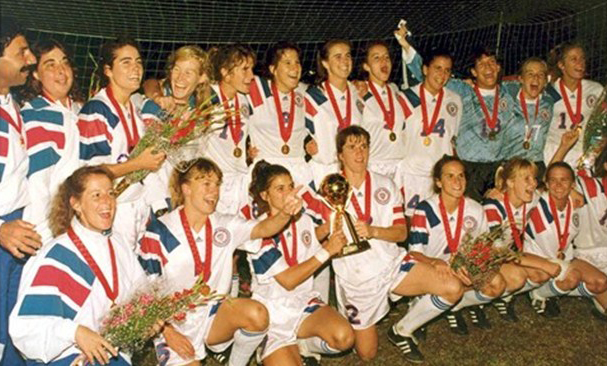Editor’s note: This article originally appeared in our 2015 World Cup issue. For the magazine, Glenn Crooks spoke with members of the 1991 U.S. Women’s National Team about their experiences at the 1st FIFA World Championship for Women’s Football for the M&M’s Cup — now known as the 1991 FIFA Women’s World Cup.
Crooks spoke with head coach Anson Dorrance, as well as Michelle Akers, Julie Foudy, Mary Harvey, and others to talk about the team’s style and culture as well as the lack of media coverage.
It was more than an hour into our phone conversation and Tracey Leone (née Bates), the current head women’s soccer coach at Northeastern University, found an old photograph of the 1991 FIFA Women’s World Cup team. She paused for a moment as she scanned the photo. I sensed she was looking at the faces of each of her teammates.
“This was a great collection of people that fit perfectly together,” said Bates of the ’91ers. “It was the perfect puzzle — not a piece was missing.”
Few teams are able to make that claim and in this case, an extraordinary group of women — with some names that still resonate — legitimized soccer in the United States after defeating Norway, 2–1, in the first women’s soccer world championship in China.
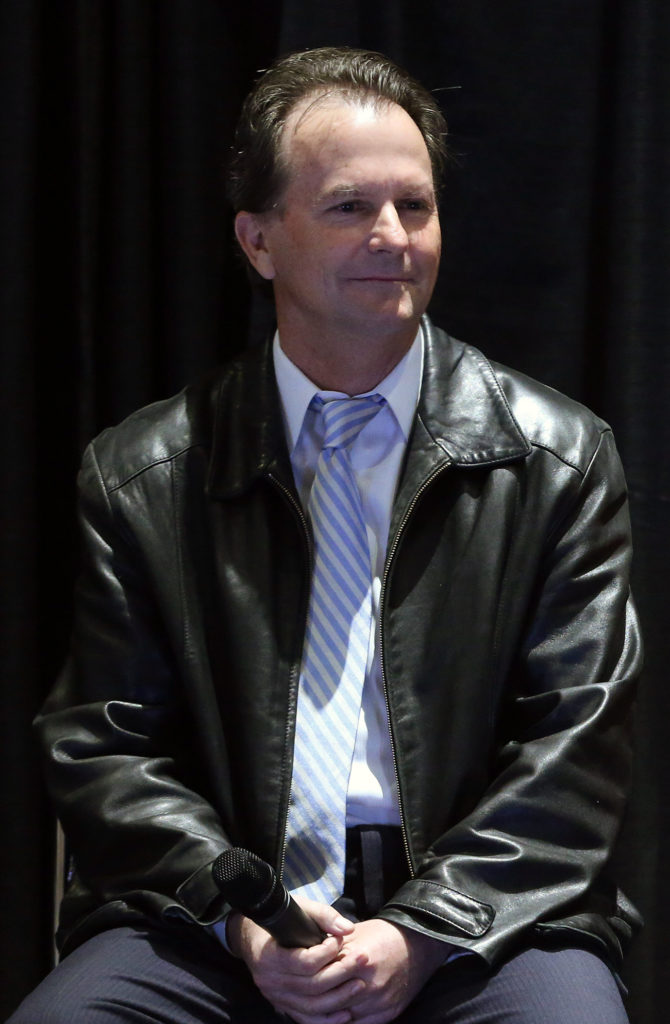 “At the time, we had a huge inferiority complex to compete at the world level in soccer,” explained Anson Dorrance, the head coach who skillfully fit those puzzle pieces together. “It was not a men’s event but it gave American soccer a modicum of prestige. We had the coaches and players to compete at the world level. We were world champions in the world’s game … their game [other countries].”
“At the time, we had a huge inferiority complex to compete at the world level in soccer,” explained Anson Dorrance, the head coach who skillfully fit those puzzle pieces together. “It was not a men’s event but it gave American soccer a modicum of prestige. We had the coaches and players to compete at the world level. We were world champions in the world’s game … their game [other countries].”
“I had to listen to all kinds of abuse,” said starting goalkeeper Mary Harvey while she lived and played in Germany from 1988–1991. “They would ask, ‘How can you be a good player, you’re from the U.S.'”
John Polis, Director of Communications for U.S. Soccer at the time, told me, “The Chinese reporters asked me before the event started, ‘Do you guys really play soccer there?'”
The Style
The U.S. Women’s National Team was born in 1985, and Dorrance was the ideal choice to replace the federation’s first coach, Mike Ryan. Upon his appointment in 1986, Dorrance sent a missive to all the players in the pool.
“If you don’t come in fit, you will be cut,” wrote Dorrance, who had already implemented a relentless, high-pressure style at the University of North Carolina — a system that has led to 22 national titles.
“I remember the utter and extreme competition in training,” said Brandi Chastain, best known for her buff penalty kick celebration at the 1999 FIFA Women’s World Cup, but at the time was a 23-year-old reserve forward for the 1991 team. “That was bred from Anson. Who can persevere? Once you stepped on the field, you already knew you won.”
Dorrance employed a unique 1-3-4-3 team shape, which enabled the maximum number of pressing areas around the pitch. There was no calculation on the defensive side of the ball — merely a constant pressing mentality.
“That team was the foundation in terms of approach,” said ESPN analyst Julie Foudy, who was studying for final exams at Stanford University while preparing to compete in matches at the 1991 championship. “That was Anson and his culture — this is who we are, not the most technical team but with high pressure everywhere.”
“It was one of the many things Anson did really well,” said Harvey, the former Chief Operating Officer of Women’s Professional Soccer for two years, the second iteration of a women’s domestic league in the United States. “It was a mentality thing that still exists and was born with that ’91 team. We felt we were going to beat Norway in the final despite giving up the lead and defending for what seemed like the entire second half. There was this aura that we were going to win that game.”
The Bond
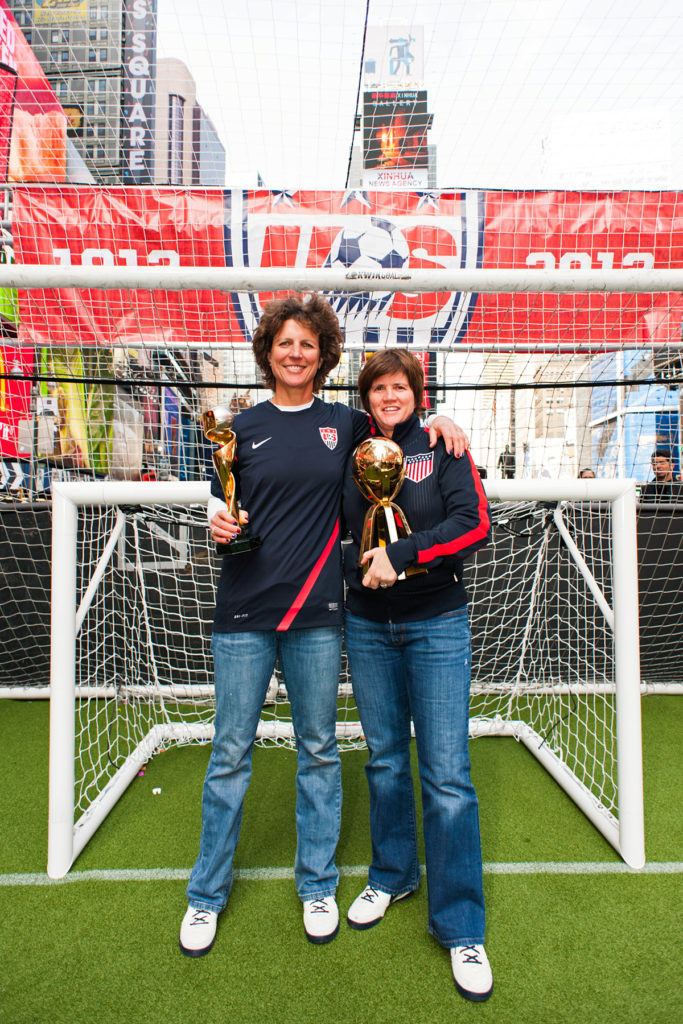
Beyond the obvious talent, was the alchemy established by the time the Americans arrived in China. Dorrance, who coached both the men and women at North Carolina from 1979–1988, had made public his claims that women had to be coached, mentored, and nurtured in a different way than the men.
I attended the NSCAA Convention in the mid-1980s and was drawn to a panel discussion on coaching women. I had recently accepted a position to manage the newly established girls’ soccer team at my alma mater, Ridge High School in Basking Ridge, New Jersey.
Dorrance was the only man on the panel. I remember Felice Duffy, then the head coach at Yale University and currently an Assistant U.S. Attorney, objecting strongly to the claims that women required special accommodations in a team environment. A majority of those present at the panel opposed the future national team coach.
Tim Crothers, author of The Man Watching: A Biography of Anson Dorrance, the Unlikely Architect of the Greatest College Sports Dynasty Ever (Ann Arbor Media Group, 2006), wrote about this in his biography of Dorrance:
“Duffy was there to argue the classical feminist viewpoint that to accept that men and women are different is to open up the possibility that the genders are unequal.”
Dr. Colleen Hacker, who later served as a sports psychologist for the USWNT, was also on the panel.
“Anson was taking quite a few hits,” said Hacker in a passage from Crothers’ book. “They didn’t like what they were hearing and they didn’t like who was saying it. I felt that many points that Anson was making were accurate.”
“She defended me while everyone else was attacking me,” Dorrance told me.
While researching the 1991 team, I noticed an oddity in the configuration of the 18-player roster.
Dorrance selected three goalkeepers and only 15 field players at an event with an unreasonably grueling schedule (six matches in 14 days) and a system that demanded constant sprints to close down opponents defensively and rampages into the attacking half when in possession.
Here I found an example of how Dorrance was attuned to the female psyche in a team environment and how the subsequent collective embrace of “team” was created with purpose.
Harvey was worked into the team during the latter stages of preparation after it appeared that Kim Maslin and Amy Allmann (now Griffin) were locked in to the first and second keeper slots.
“Mas [Maslin] was the starter until Mary came in,” said Tony DiCicco, the keeper coach in 1991. “Mas and Amy were good keepers, but Mary was the best of the three.”
“It was hard on us for sure,” recalled Griffin. “It was done so last minute. I was bummed. Mary hadn’t been to any of the training camps.”
“I acknowledge that it must have been hard for me to come in so late and my heart goes out to them,” said Harvey, who was playing 60 matches a year in Germany compared to a pair of training camps annually for Maslin and Allman.
“She was getting way more competition than us,” said Griffin. “And one of us wasn’t going to go to China.”
Late in the final training camp, Megan McCarthy, the team’s stalwart sweeper, suffered a torn ACL. Consequently, Dorrance had to ponder a replacement field player — certainly, he wasn’t going to bring three keepers to China?
“I was about to make cuts and Joy [Biefeld] Fawcett approached me,” Dorrance told me. “She implored me to keep both Kim and Amy. She said it was important for the team — they wanted to be with all the people they liked.”
He suspected there was a strong sentiment that the overriding team opinion was, “They’re coming, figure it out.”
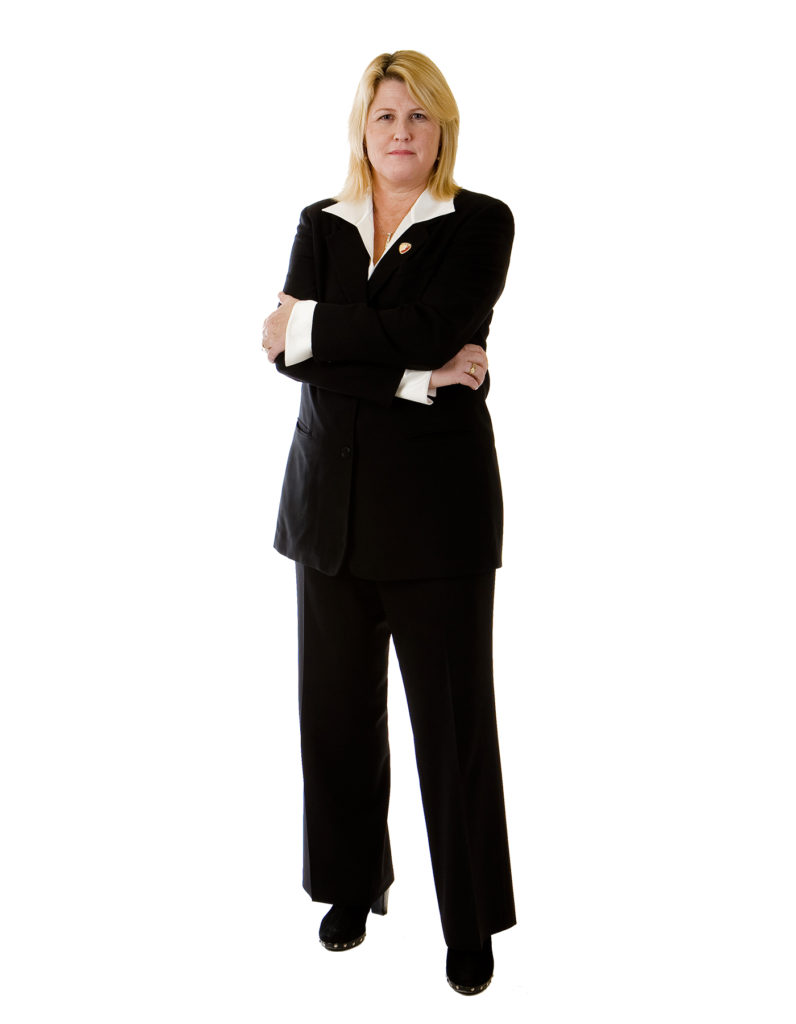
Dorrance was sensitive to the needs of his female group. He had to take Harvey, Maslin, and Griffin at the risk of field player attrition. He concluded that the greater risk was to leave behind one of the beloved members of the squad.
“I think it was great for team chemistry,” said Griffin (née Allmann), now the top assistant at the University of Washington. “I was made to feel a big part of the team. I told Mary, ‘I want to win a World Cup so tell me what you need.'”
At the White Swan Hotel after the 2–1 victory over Norway in the final, Dorrance was sequestered in his room, but was finally urged to join in on the celebration.
“Amy was a fabulous comedic poet,” Dorrance said. “I reluctantly went down and Amy read her poem.”
“It was a bit of slapstick, a bit of a roast,” said Griffin. “I made fun of just about everyone on the team. I was a little uncomfortable with Anson, but he laughed his butt off.”
“It was one of the warmest celebrations,” said Dorrance. “We just enjoyed each other’s company.”
The gratification was the product of a troupe that welcomed the team concept. It was a concept players like the 4’11” Leone, nicknamed the “tiny terminator,” bought into.
“I embraced the role of making the starting group better,” said Leone, a full-time player for Dorrance at the collegiate level. “Myself, [Wendy] Gebauer, Chastain, Allmann [Griffin], Maslin — we were all in that reserve role. We valued our role and appreciated every single day. We didn’t know if this was ever going to happen again in our lifetime.”
According to Leone, it was a moment in the second match against Brazil that she viewed as a microcosm of the ’91ers. Starter Kristine Lilly was nursing an injury. As a result, Bates and Debbie Belkin began to warm up midway through the second half. Belkin’s name was called.
“She looks up at me and mouths the words, ‘I’m sorry,'” said Bates, the memory evoking tears almost 24 years later. “It was the sweetest thing a teammate’s ever done. I was so touched that in the biggest moment of her life she would think about me. It was an example of the great chemistry on this team.”
The Game
Before 65,000 at Tianhe Stadium in Guangzhou, at that time the largest crowd to view a women’s sporting event, the U.S. met Norway for the inaugural world championship in women’s soccer.
The Chinese government made certain all matches were played to full capacity. Factory workers were ordered to attend the games; one section rooting for one team while another section supported the other team.
“It was a remarkably quiet 60,000,” recalled April Heinrichs, captain of the U.S. squad.
“They were all trained how to react,” explained Dorrance, whose college team had defeated Wisconsin for the NCAA National Championship while he was preparing the U.S. team in China. “Every seat was taken.”
“Everyone wore gray, drab garb,” remembered Polis. “You would see large blocks of gray-clad fans.”
For this event, FIFA didn’t permit the use of “World Cup” in the official tournament name. They failed to trust the product even though a trial run in China three years earlier proved successful. Consequently, teams were playing for the M&M’s Cup since Mars Candy was the lone corporate sponsor for the event. The official name of the tournament is 1st FIFA World Championship for Women’s Football for the M&M’s Cup.
To add further insult, FIFA elected to play 80-minute matches “to make things easier on the ladies.”
“That was stupid, disappointing,” said Michelle Akers, whose five goals in the quarterfinal against Chinese Taipei remains a single-game record.
However, contained in its own technical report for the tournament (page 52), the U.S. may have inadvertently supported the idea. Its statement was based on occurrences from the FIFA Women’s Invitation Tournament, the dry-run event in 1988 won by Norway.
“At that time there were many teams whose players had serious fitness problems towards the end of the 80-minute game,” reads the report.
Most players, already accustomed to club and collegiate contests with two 45-minute periods, responded with sardonic chuckles when asked about the length of the matches.
“I was in the room when they were also talking about a size four ball,” said Akers, who owns a rescue farm for horses and purchases 700 bales of hay annually.
In the final, the U.S. gained the advantage in the 20th minute off a set piece served in from Shannon (Higgins) Cirovski to Akers. Higgins’ assist came from 30 yards — using a size five ball.
“I was walking towards the ball and Akers was on it,” said Cirovski, the team’s maestro. “I looked at her and said, ‘Go get in the box and I’ll hit you on the head.'”
The service was true and the timing of the leap and forehead contact was a portrait of perfection and a moment in history that was nearly prevented by a sharp directive from the touchline.
“I didn’t know this until months later, but Anson was screaming, ‘Let Michelle have it! Let Michelle have it!'” said Cirovski, one of nine players on the roster who played for Dorrance at North Carolina. “Well, I have a hearing deficiency and I can’t hear anything from the sidelines.”
Nine minutes later, it was 1–1 after Carla (Werden) Overbeck collided with Harvey and forward Linda Medalen alertly accepted the gift to equalize for the Norwegians, the “Viking Bitches” as they were called by the U.S. side.
“That goal shook me up,” said Harvey. “I was a different person by the end of that match. It was life-changing. Bad things happen. The only thing you can control is how you respond to it.”
“I remember thinking, ‘I’m so glad she’s on our side,'” said Overbeck, who has been an assistant coach at Duke for the past 23 years. “One time I looked back and Harv was just flying through the air.”
“We said at halftime that we just needed to get behind them,” said Cirovski, who played the entire event listed as questionable with a fifth metatarsal stress fracture in her left foot. “I knew on a half-turn I could get them.”
With an advanced ability to scan the field, which Cirovski credits to her hearing deficit, she took a glance over her shoulder in the 78th minute before delivering what would prove to be the game-winning sequence and propel women’s soccer into the global discussion.
“The defender was there but Michelle got it off her,” said Cirovski of her 40-yard service on a broken plant foot. “After that, it seemed like slow motion.”
With a combination of power and grace, Akers found herself driving at the keeper, who had committed to take the ball off Akers’ foot. The 5’10” Akers, who would later earn the nickname Mufasa (a The Lion King reference) for her considerable mane, touched the ball past the keeper with the outside of her left foot. The ball remained on her left foot at the top, left edge of the six-yard box with an empty net waiting. The depictions from the players and coaching staff on what happened next vary but they all agreed on one thing: It was an agonizing wait for Akers to deliver the game-winner.
“I remember thinking, is this ever going in?” said Cirovski as she observed from the center circle, just inside her own half.
“You know the moment is coming,” said Chastain, who didn’t play in the final. “I remember beginning to slowly creep out of my seat.”
“We were freaking out,” said marking back Linda Hamilton.
“It absolutely felt like time had stood still,” added assistant coach Lauren Gregg, who had been assigned to pick the shooting list and order for penalty kicks.
Instead of using her left foot to finish, Akers ran around the ball to place it on her right. The maneuver was intentional based on hours of training.
“I got so much shit about that,” said Akers of the drawn-out winner. “From practicing, if the ball is rolling away to the left and you hit it with your left, unless you hit it perfectly, there is a margin of error. On my right, I had the ball width to hit it to go in. I just passed it into the goal.”
“I knew what I was doing,” continued Akers, who along with Lori Henry were the only remaining original members from the 1985 team. “I just took a breath. It’s the thing you train for your whole life, to take the last shot to win the World Cup. Who gets that chance?!”
“It’s a good thing we didn’t go to penalties,” Gregg told me. “I couldn’t get anyone to take it. I learned it’s about preparation. We were not ready for that moment.”
“[Carin] Jennings was number 10 on our list,” said DiCicco. “That gives you an idea of how unprepared we were.”
The Coverage and Reception
On December 1, 1991, the triumphant Americans left China for the 16-hour flight that landed at JFK International Airport in New York. President George H. W. Bush wasn’t there to greet the team, let alone TV or radio crews. There were no screeching 12-year-olds held back by ropes as arms stretched forward with replica national team jerseys for autographs.
The only individuals there to welcome the best collection of female soccer players in the world were Thom Meredith, the Director of Event Operations for U.S. Soccer, and Bora Milutinović, head coach of the U.S. Men’s National Team. Meredith would later resign from his post with U.S. Soccer to become Vice President of Operations for Women’s United Soccer Association, the first women’s professional soccer league in the U.S.
This team won a world championship and due in part to the paucity of media coverage, would live in relative anonymity back home.
“Nobody knew we had won,” said DiCicco. “There was no news media or anything. We landed, said goodbye, and split. That was pretty much it.”
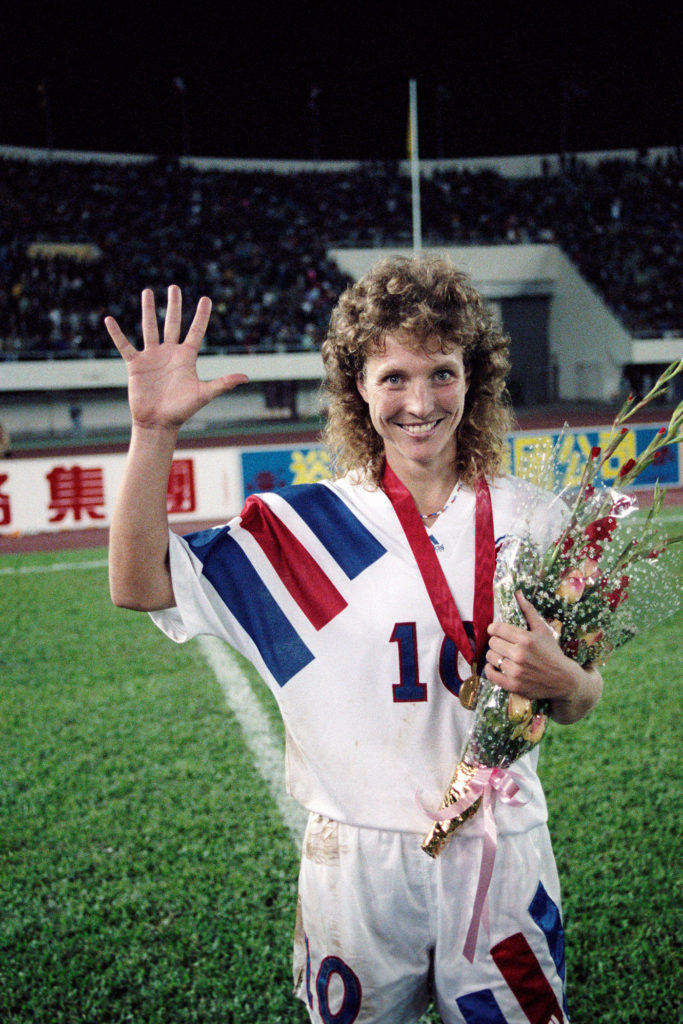
“I got back to Stanford and everyone was asking, ‘Where the hell have you been?'”’ said Foudy, who played for the Cardinal without an athletic scholarship. “I figured I would get a little break from my professors. But no, it was kind of like, ‘Who cares? Sit down and take this test.'”
“It was disappointing to say the least,” said Lilly, the all-time leader in senior caps, who was a 20-year-old at the time. “We had just accomplished something no one in American soccer had accomplished.”
“The thing that bummed me out the most is that everyone had to race to their connecting flights,” said Griffin. “We didn’t realize that it was the last time we would be together. I think of giving someone a better hug, or saying something more meaningful.”
“We thought we had conquered the world,” said Mia Hamm, the only teen in the squad. “There was one media member there.”
And that one journalist had been on the flight back with the team.
“It was such a great unknown,” said Ridge Mahoney, the Soccer America writer who met his future wife, Xiu Ping, during the journey.
Mahoney’s report on the final wasn’t read in the states until 10 days after the U.S. victory.
SportsChannel America provided television coverage but few had access to the tape-delayed broadcasts, which ran commercials during the run of play. Former North American Soccer League player Matt Bahr, noted more for his place-kicking prowess in the National Football League, provided the color analysis, calling Heinrichs, “Heinrich” during the telecasts.
It was an era without the Internet or social media. Even the most enthusiastic supporters, including myself, had difficulty securing the details from China.
“Our federation didn’t come till our semifinal,” said Akers. “We didn’t care, it was about our team — about being an American team.”
Talent and Power
“I would argue that the ’91 team is the greatest that has represented the U.S.,” said Hamilton, who serves on the U.S. Soccer Board of Directors. “You’ve got seven, eight, or nine of the greatest players that ever played the game.”
Along with Akers, who won the Golden Boot with 10 goals, there was Most Valuable Player Carin (Jennings) Gabarra with six goals, and Heinrichs, who required knee surgery only eight weeks prior to the affair.
“I told Anson he should give my starting position to a healthier, deserving player,” said Heinrichs, who had the game-winning goal in two group matches and scored twice in the semifinal victory against Germany. She finished with four goals, tied for sixth among all players.
“Luckily, it all worked out the way we hoped and dreamed,” she said.
That forward trio, which combined for 85 percent of the American tallies, was aptly nicknamed “the triple-edged sword” by a Chinese journalist.
The midfield was Foudy, Hamm, Lilly, and Cirovski. In addition to backs Hamilton and Fawcett was the sweeper, Overbeck, with Harvey in goal.
“Every game at practice was much harder than any game we would play,” said Hamilton, who coaches collegiately at Southwestern University in Austin, Texas. “It’s why I was a good defender — look who I was playing against every day. Players like Akers. It was insane.”
“Akers is the most complete soccer player in the history of the game,” said Dorrance. “And no one had seen a player like Jennings before. The way she beat people off the dribble; in your face, combative.”
“I almost got suspended from second grade for refusing to square dance,” said Gabarra, who has been the women’s soccer head coach at the U.S. Naval Academy for 22 years and is married to former U.S. men’s national teamer, Jim Gabarra. “I went outside to play baseball with the boys.”
Similar stories are numerous with this group of 18 pioneers. And it was a comparable intensity and belligerence which led to an entertaining style that facilitated the rapid growth of the sport.
“It was the manner in which we won,” claimed Gregg, who played on and won the first national championship at North Carolina. “The physicality, relentlessness, the athleticism — that women could play as intensely and passionately as men. I don’t think it would have mattered that we won without having all these qualities. It caught FIFA’s attention.”
In the U.S.’s technical report under “Criteria For Selection,” the first item listed was “Physical Capacity (Fighting Power).”
“We proved that women could be competitive and powerful,” said Chastain. “There was something about that, it would attract people.”
Still, without Akers’ soccer acumen in the pressurized final moments of the championship match, the progress of the women’s game may have stalled.
“If we finish second, less resources would have been put toward ’95 and who knows if we then have success in ’96,” said Heinrichs, now the U.S. Soccer Federation’s Technical Director for Women’s Soccer. “It’s just the way the USA is wired. Winners garner more attention and resources.”
We recognize the devotion of that first championship team, playing with no salaries or endorsements or insurance while earning but $10 per diem with inadequate publicity and gear, plus minimal residency. The players had to keep up with their soccer homework assignments.
“The players largely had to prepare themselves as we had so few training camps and games,” said Heinrichs, who served as the national team coach from 2000–2005.
“Anson would call you and say, ‘Are you fit?'” said Foudy. “We’re going to China in two weeks.”
Their perseverance has led to a professional league supported by the USSF and full-time wages and medical insurance for the national team.
“You played for the honor of representing your country and your teammates,” said Leone, the first American to play and coach on a world championship team. “That’s pretty much it. Most people didn’t know we had a team.”
In Italy, when striker Carolina Morace returned from China, she was received as a conqueror. At a time when Diego Maradona was tantalizing supporters in Napoli, one Italian commentator remarked, “When children are born, all boys should be called Diego and all girls, Carolina.”
Morace scored four goals in China. Akers scored more goals than six of the 12 teams at the championship.
“We came home to nothing, no one knows, no one cares,” said Foudy, who played in four World Cups. “This isn’t going to be easy but we’re going to get this sport off the ground in this country. That was our attitude.”
“That ’91 team was the silent trigger,” concluded Heinrichs.
And with the current U.S. team set for its World Cup opener against Australia, they can take inspiration from the sacrifices made by those athletes before them — that small collection of standard bearers more commonly known as The ’91ers.

